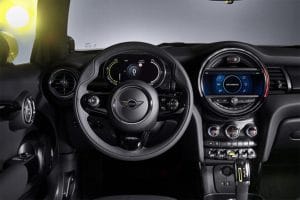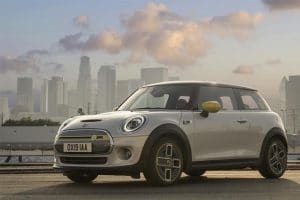The new Mini Cooper SE will carry a base price of $29,900, the British automaker announced today, making it one of the most affordable all-electric models on the market.
But there’s a trade-off. While Mini hasn’t formally announced U.S. range for the SE model, it said it expects the hatchback to yield up to 169 miles using the new European WLTP test cycle. The EPA test is likely to bring that down below the 150-mile mark.
“U.S. pricing of the new Mini Cooper SE was set to establish this new battery electric as a true class leader in making premium electric mobility more accessible to a broader range of customers,” said Michael Peyton, Vice President, Mini of the Americas. “We at Mini are pleased to offer more people the ability to experience a drive charged with passion in the form of the Mini Cooper SE, an EV that is built ‘for the drive.’”
(The Mini Cooper SE debuts at 2019 Frankfurt Motor Show. Click Here for all of the show’s coverage.)
Mini has toyed with bringing a battery-electric vehicle to market for some time, and fielded a number of prototypes in U.S. and European test fleets earlier in the decade. But this will mark the first time it is offering a BEV for retail sale.

While it looks just like a gas-powered Mini Cooper hatchback, the SE shares the underlying platform used for the all-electric BMW i3.
The 2020 Mini Cooper SE looks pretty much just like the current, gas-powered Mini Cooper, but it actually relies on the same underlying platform as the all-electric BMW i3. A key difference is that it doesn’t make use of the super-light carbon fiber body panels of the Bavarian battery-car, something that further limits range.
Under the skin, the British battery-electric vehicle, or BEV, relies on a 32.6 kilowatt-hour battery mounted under its floorboards. That means it doesn’t sacrifice interior or cargo space, though its body does sit almost an inch higher than a stock Mini Cooper.
Other than that, it looks much like a conventional Mini, inside and out. There are some cues that the SE is electric, however, including various yellow accents, including a decorative bar crossing the grill and mirror caps. The grill, as we’ve seen with a number of new BEVs, is largely sealed off because of the much lower need for cooling air on an electric vehicle.
Inside, the gauge cluster has special displays for tracking, among other things, the battery’s state-of-charge. The SE offers a higher level of standard content than the Mini Cooper S, including LED headlamps, a twin-zone auto climate system, and onboard navigation that also helps a driver track down nearby charging stations.
The hatchback is powered by a single electric motor driving the front axle. It produces 184 horsepower and 199 pound-feet of torque. The gas-powered, or ICE, Mini Cooper turns out 134 hp and 162 lb-ft, the Cooper S bumping that up to 189 hp and 207 lb-ft.
The all-electric SE will hit 100 kmh, or 62 mph, in 7.3 seconds, the automaker claims, a tenth of a second quicker than the gas-powered Cooper hatchback — but nearly a full second slower than the Cooper S — so buyers won’t be in for the sort of aggressive launches that some of the newer BEVs are delivering.
On the other hand, the automaker notes, the low positioning of both the motor and battery pack does offer some advantages, its news release pointing out that, “Along with the lower center of gravity, this gives the electrically powered model agile handling, making it supreme and easy to control even when cornering at high speed.”
(Ford teases upcoming “Mustang-inspired” electric SUV. Click here to check it out.)
As for charging, the battery is small enough to plug in and get back to running relatively quickly, especially when using a Level 3 Fast Charger. It can handle a maximum 50 kW – not the 150 to 350 kW Level 3 chargers some new competitors, like the Audi e-tron and Porsche Taycan can plug into — but that’s enough for an 80% recharge in 35 minutes, the automaker says. It also can plug into a 120 volt socket, if nothing is available, though for home and office use a Level 2, 240-volt system is preferred. Charging times for the 7.4 kilowatt system weren’t released but should be something on the order of four or five hours, based on what vehicles with similar-sized batteries require.

The interior also looks familiar, though the gauge and infotainment cluster are slightly modified. Among other things, the navi system will help owners find EV charging stations.
Dropping below $30,000 – before factoring in $850 in delivery fees – could help overcome its range limitation for potential buyers who are likely to use it in urban applications or as a second commuter car. In some locations, the final price tag could drop below $20,000 after factoring in the federal $7,500 tax credit and additional state and local incentives.
Whether that will matter remains to be seen. Buyers are clearly expressing a desire for as much range as possible. Nissan’s second-generation Leaf also targeted a number around 150 miles but generated little market enthusiasm. Its Leaf Plus now pushes over the 200 mile mark, though demand is still well below what the Japanese EV achieved early in the decade after becoming the first mass-market EV on the retail market.
(Nissan reveals new Ariya electric SUV at Tokyo Motor Show.)
Chevrolet, by comparison, now offers 259 miles range after extending the range of the 2020 Bolt EV, and the long-range edition of the Tesla Model 3 has an EPA rating of 310 miles.
The BMW subsidiary isn’t announcing sales targets for the 2020 Mini Cooper SE. It plans to have the first all-electric models in U.S. showrooms next March.


